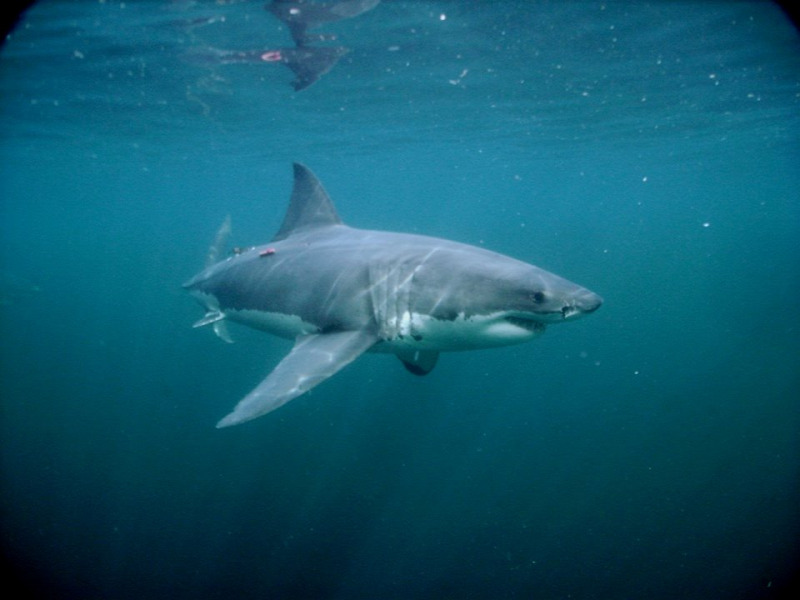A great white shark was seen this morning in front of the resort of Hurghada, which is frequented by tourists on the Egyptian coast of the Red Sea. The famous sea predator was captured from the deck of a submarine while floating just below the surface. The news is of particular interest because the Red Sea great white is not a native shark species, and thus is also considered in the literature as a marine area free of great white sharks.
He slowly approached the ship, and when he got there everyone was shocked
On the morning of March 10, in front of the beaches of the popular resort of Hurghada overlooking the Red Sea, in the area bordered by the reefs of Fanous and Fanadir, in the so-called Arab region, large triangular stagnant water permeated the surface of the water. Observed from aboard a submarine.

It was immediately clear from the shape and movement of the dorsal fin that red bottled dolphins were not particularly common in the Hurghada area (Tursiops truncatus truncatus) But a shark approaches the ship.

The unusual scene was also filmed by Hatem Sharkawy, one of the employees, which can be viewed embedded here. However, the real settlement was yet to come, for when the predator approaching the comet reached the ship,
It turns out that it is not a domestic species,
But under the surface of the Red Sea, a silhouette of a very great white shark appeared.

Obvious features of the species, a short strongly prominent platform (nose), broad crescent-shaped busts, long gill arches, squat trunk, dorsal fin shape, and asymmetric (symmetrical) tail fin all demonstrate that the white shark (Carcharodon carcharias) appeared in the waters of Hurghada.

The ship’s crew has already reported the sighting to the Hurghada Environmental Protection and Conservation Authority (HEPCA), but it is not yet known if local authorities have closed beaches or what other safety measures are being taken.
At the moment, the increased caution on the part of holidaymakers in Hurghada does not hurt
Precautionary rules can be justified in any case, since the principle of territoriality also applies to large whites who follow nomadic lifestyles and travel very long distances. The principle of territoriality means that if you find an area rich in prey for an immigrant lifestyle, you can spend more time there and even temporarily move to a resident lifestyle.

There are many examples of this in the case of the great white shark, including some stretches of coast on the coast of South Africa rich in fur seals. The Hurghada area is home to a relatively large number of bottlenose dolphins in the Red Sea, and dolphins are important prey animals for large eggs. Of course, the rare guest could not be immediately ruled out, but for the time being, heightened caution was not harmful.

It is not recommended to swim deeper than the beach, especially not on your own. It is also best to temporarily suspend solitary dives around so-called reefs or small coral formations in shallow waters near beaches. Early in the morning we avoid going into the water for the first two or three hours after sunrise, because this time of the day is the busiest time for great white prey.

We also avoid urinating in shallow water or slapping the water vigorously, as all of these can be a strong incentive for a great white shark that may be nearby. Finally, those on vacation now in Hurghada should find out locally what formalities, if ordered, the shoreline transitional closure.
So far, only one true scene is known about the Red Sea
According to the current scientific knowledge, there are 47 species of sharks whose original habitat is the Red Sea. The Red Sea is not considered the home of the great white shark because the species is extremely rare here. The only reliable sighting of a great white shark in the Red Sea to date comes from world-renowned Austrian pioneer marine biologist Professor Hans Haas, who met a large specimen at Sanganeb Atoll in Sudan in 1950, breaking a coral wall.

Although the great white shark is an inhabitant of the world’s seas, the species prefers primarily cool temperate waters. It is an interesting observation that they are much rarer in the tropics, visiting large samples that are older than the waters of the equatorial belt.

It is relatively common in the tropical waters around Hawaii, but has been observed in the Caribbean off the coast of Cuba, in the Indian Ocean off the Maldives, in the Pacific Ocean in Taiwan, in the Philippines and Australia, and even more recently in the region – in the tropical waters of South Wales.

Its most common regions are the California coast in the western United States, the Massachusetts coast on the east coast, the coastal waters of South Africa, the Perth region in Western Australia, and the Neptune Island region in the south. The Mediterranean Radio Species is located in the area bordered by Malta, Cape Bon and the Strait of Messina.

How and from where the specimen that appeared in Hurghada entered the somewhat secluded Red Sea is still highly questionable. It was likely that he swam in the Indian Ocean through the Bab al-Mandab strait, but theoretically it cannot be excluded that he came from the Mediterranean, passing through the Suez Canal.






